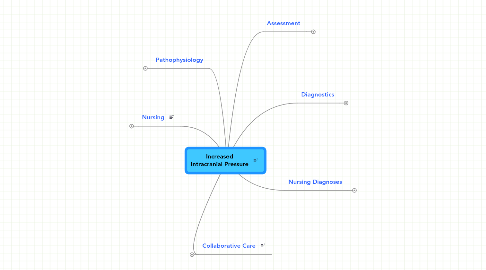
1. Nursing
1.1. maintenance of respiratory function
1.1.1. airway
1.1.2. positioning
1.1.3. no suctioning/coughing
1.1.4. abdominal distention
1.1.5. ABGs
1.2. fluid and electrolyte balance
1.2.1. I&O, daily weights
1.2.2. glucose, Na+, K+
1.3. monitoring of intracranial pressure
1.3.1. ventriculostomy
1.4. body position
1.4.1. HOB up
1.4.2. slow and gentle
1.4.3. avoid valsalva maneuvers
1.4.4. avoid extreme hip flexion
1.5. protection from injury
1.5.1. confusion, agitation
1.5.2. seizure percautions
1.5.3. avoid restraints
1.5.4. quiet nonstimulating environment
1.5.5. family presence
1.6. psychologic considerations
1.6.1. simple explanations
1.6.2. support
1.6.3. education
2. Pathophysiology
2.1. brain tissue
2.2. blood
2.3. cerebrospinal fluid
3. Collaborative Care
3.1. oxygenation
3.1.1. ABG analysis guides therapy
3.1.1.1. endotracheal intubation
3.1.1.2. mechnical ventilation
3.2. drug therapy
3.2.1. osmotic diuretics
3.2.2. corticosteroids
3.2.3. high-dose barbiturates
3.3. hyperventilation therapy
3.3.1. target CO2 to 30-35 mm Hg
3.4. nutritional therapy
3.4.1. enteral nutrition
3.4.2. parenteral nutrition
3.4.3. fluid therapy - keep normovolemic
4. Assessment
4.1. change in level of consciousness
4.2. change in vital signs
4.2.1. Cushings Triad
4.2.1.1. increasing systolic pressure
4.2.1.2. bradycardia
4.2.1.3. irregular respiratory pattern
4.3. ocular signs
4.4. decrease in motor function
4.5. headache
4.6. vomiting
5. Diagnostics
5.1. computed tomography (CT) scan
5.2. magnetic resonance imaging (MRI)
5.3. skull and spinal x-ray studies
5.4. electroencephalogram (EEG)
5.5. angiography
5.6. laboratory studies
5.6.1. complete blood count (CB)
5.6.2. coagulation profile
5.6.3. electrolytes
5.6.4. arterial blood gases (ABGs)
5.6.5. ammonia level
5.6.6. general drug and toxicology screen
5.6.7. CSF protein
5.6.7.1. lumbar puncture
